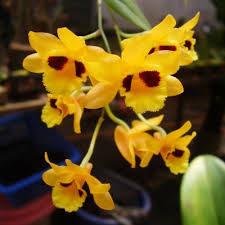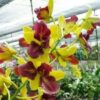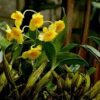# Essential Tools for Caring for Dendrobium Orchids

Caring for Dendrobium orchids, one of the most popular types of orchids, requires specific tools and equipment to ensure these beautiful plants thrive. Known for their vibrant colors and exquisite flowers, Dendrobium orchids are a favorite among gardeners and flower enthusiasts alike. This article will outline the essential tools needed for the proper care of Dendrobium orchids, including their functions, how to use them, and why they are important.
## 1. Introduction to Dendrobium Orchids
### 1.1 What are Dendrobium Orchids?
Dendrobium orchids belong to the Orchidaceae family and are native to tropical and subtropical regions of Asia, Australia, and the Pacific Islands. With over 1,800 species and numerous hybrids, Dendrobium orchids are known for their diverse colors, shapes, and sizes. They typically bloom in various shades of white, pink, purple, and yellow, making them popular choices for home gardens and floral arrangements.
### 1.2 Why Care for Dendrobium Orchids?
Caring for Dendrobium orchids requires attention to detail, as these plants have specific needs regarding light, temperature, humidity, and water. Proper care can result in stunning blooms that can last for weeks, providing beauty and fragrance to any space. Understanding the tools needed for orchid care can help you cultivate a healthy and vibrant Dendrobium orchid collection.
## 2. Essential Tools for Orchid Care
### 2.1 Potting Supplies
#### 2.1.1 Orchid Pots
**Function:** Orchid pots are specifically designed to provide adequate drainage and airflow to the roots, which is crucial for the health of Dendrobium orchids.
**How to Use:** Choose pots made from materials like clay or plastic with drainage holes at the bottom. When potting your orchids, ensure the pots are not too deep, as Dendrobium orchids prefer to be somewhat shallow in their pots.
#### 2.1.2 Potting Medium
**Function:** The potting medium supports the orchid’s roots while providing essential drainage and aeration.
**Types of Medium:**
– **Orchid Bark:** Made from fir or pine bark, this is the most common medium for Dendrobium orchids. It allows for excellent drainage and airflow.
– **Coconut Coir:** This sustainable option retains moisture while providing good aeration.
– **Sphagnum Moss:** This medium retains moisture but should be used sparingly as it can hold too much water if not monitored closely.
**How to Use:** Mix different components to create a custom potting medium that suits the specific needs of your Dendrobium orchids. The ratio can vary, but a common mix is 60% bark, 30% coir, and 10% perlite.
### 2.2 Watering Tools
#### 2.2.1 Watering Can
**Function:** A watering can helps control the amount of water applied to the orchids, ensuring they receive adequate moisture without overwatering.
**How to Use:** Choose a watering can with a narrow spout for precise watering. Water the orchids until water drains out of the bottom of the pot, and avoid letting them sit in standing water.
#### 2.2.2 Humidity Tray
**Function:** A humidity tray can help maintain the humidity levels that Dendrobium orchids thrive in.
**How to Use:** Fill a shallow tray with pebbles and water, ensuring the water level is below the top of the pebbles. Place your orchids on top of the pebbles. As the water evaporates, it will increase the humidity around the plants.
### 2.3 Light Management Tools
#### 2.3.1 Grow Lights
**Function:** If natural light is insufficient, grow lights provide the necessary light spectrum for healthy orchid growth.
**How to Use:** Set up LED grow lights above your orchids, ensuring they are positioned at an appropriate distance to prevent overheating. Most Dendrobium orchids require around 12-14 hours of light per day.
#### 2.3.2 Light Meter
**Function:** A light meter measures the amount of light in your growing area, helping you ensure your orchids receive adequate light.
**How to Use:** Hold the light meter near your orchids to determine the light intensity. Adjust your light sources accordingly, either by moving your orchids or adjusting your grow lights.
### 2.4 Fertilizing Tools
#### 2.4.1 Fertilizer
**Function:** Fertilizer provides essential nutrients that Dendrobium orchids need to thrive.
**Types of Fertilizer:**
– **Balanced Orchid Fertilizer:** A 30-10-10 or 20-20-20 NPK ratio is ideal for orchids during their growing season.
– **Slow-Release Fertilizer:** This type of fertilizer releases nutrients over an extended period and can be mixed into the potting medium.
**How to Use:** Dilute the fertilizer to half-strength and apply it every 2 to 4 weeks during the growing season. Reduce fertilization during the dormant season.
#### 2.4.2 Measuring Spoon
**Function:** A measuring spoon helps ensure you apply the correct amount of fertilizer.
**How to Use:** Use the measuring spoon to portion out the fertilizer based on the manufacturer’s recommendations, ensuring you don’t over-fertilize your orchids.
### 2.5 Pruning Tools
#### 2.5.1 Pruning Shears
**Function:** Pruning shears are essential for removing dead or damaged leaves and spent flower spikes.
**How to Use:** Choose a sharp, sterilized pair of pruning shears. Cut away any yellowing leaves or spent blooms close to the base to promote healthy growth and airflow.
#### 2.5.2 Sterilizing Solution
**Function:** Keeping your pruning tools clean prevents the spread of diseases.
**How to Use:** Use a 10% bleach solution or rubbing alcohol to sterilize your pruning shears before and after use. This practice helps protect your orchids from infections.
### 2.6 Pest Control Tools
#### 2.6.1 Insecticidal Soap
**Function:** Insecticidal soap effectively controls common pests such as aphids, spider mites, and mealybugs.
**How to Use:** Spray the affected areas of the orchid thoroughly, making sure to coat both the tops and undersides of the leaves. Follow the manufacturer’s instructions for frequency and application.
#### 2.6.2 Neem Oil
**Function:** Neem oil is a natural pesticide that can help control pests and fungal diseases.
**How to Use:** Mix neem oil with water according to the instructions and spray it on the affected plants. This treatment works best when applied in the early morning or late evening to avoid leaf burn.
### 2.7 Environmental Control Tools
#### 2.7.1 Thermometer
**Function:** A thermometer helps monitor the temperature in the environment where your orchids are growing.
**How to Use:** Place a thermometer near your orchids to ensure they are in the appropriate temperature range (65°F to 85°F or 18°C to 29°C during the day and cooler at night).
#### 2.7.2 Hygrometer
**Function:** A hygrometer measures humidity levels, which are crucial for Dendrobium orchids.
**How to Use:** Position the hygrometer in the same area as your orchids to monitor humidity levels. Ideal humidity for Dendrobium orchids is between 50% and 70%. If levels are low, consider using a humidifier or misting your orchids.
### 2.8 General Maintenance Tools
#### 2.8.1 Gloves
**Function:** Gloves protect your hands while handling potting materials and fertilizers.
**How to Use:** Choose gloves made from a durable, flexible material that allows for easy movement while providing protection.
#### 2.8.2 Trowel
**Function:** A small trowel is useful for repotting orchids and mixing potting mediums.
**How to Use:** Use the trowel to scoop and mix potting materials and gently remove old potting media from the orchid’s roots during repotting.
## 3. Using Your Tools Effectively
### 3.1 Establishing a Care Routine
To maintain healthy Dendrobium orchids, it’s essential to establish a consistent care routine. Here are some tips:
– **Weekly Check-Ins**: Regularly inspect your orchids for signs of pests or diseases. Check the moisture level of the potting medium and adjust your watering schedule accordingly.
– **Monthly Fertilizing**: Schedule monthly fertilizing during the growing season, using your measuring spoon for accuracy.
– **Seasonal Pruning**: Prune dead or damaged leaves and spent flowers as needed to promote healthy growth.
### 3.2 Adjusting to Seasonal Changes
As the seasons change, so do the care requirements for Dendrobium orchids. Monitor temperature and humidity levels regularly, making adjustments to your care routine based on seasonal conditions.
– **Spring/Summer**: Increase watering and fertilizing as your orchids enter their active growing season. Ensure they receive adequate light, especially if they are growing indoors.
– **Fall/Winter**: Reduce watering and stop fertilizing as your orchids enter dormancy. Maintain adequate humidity and protect them from cold drafts.
## 4. Troubleshooting Common Issues
### 4.1 Overwatering
**Symptoms:** Yellowing leaves, mushy roots, and mold growth on the potting medium.
**Solution:** Allow the potting medium to dry out before watering again. Ensure pots have adequate drainage and consider using a well-draining potting medium.
### 4.2 Underwatering
**Symptoms:** Wrinkled or shriveled leaves and dry potting medium.
**Solution:** Water your orchids thoroughly, ensuring the water drains out of the bottom of
the pot. Increase your watering frequency if needed.
### 4.3 Pest Infestation
**Symptoms:** Visible pests on the leaves, sticky residue, or webbing.
**Solution:** Apply insecticidal soap or neem oil as a treatment. Regularly inspect your orchids for early signs of infestation to prevent major outbreaks.
## 5. Conclusion
Caring for Dendrobium orchids can be a rewarding endeavor, and having the right tools is essential for their success. From potting supplies to pest control, each tool plays a critical role in maintaining the health and beauty of these exquisite plants. By understanding how to use these tools effectively and establishing a regular care routine, you can cultivate stunning Dendrobium orchids that will bring joy and elegance to your home or garden. Embrace the journey of orchid care and enjoy the vibrant blooms that Dendrobium orchids have to offer.

